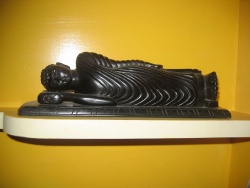Difference between revisions of "Euthanasia"
(Created page with "thumb|250px| Euthanasia is the act of intentionally killing a patient by performing or withholding medical procedures. Euthanasia ...") |
|||
| Line 1: | Line 1: | ||
[[File:Buddha_lying_down_london_dec_07.jpg|thumb|250px|]] | [[File:Buddha_lying_down_london_dec_07.jpg|thumb|250px|]] | ||
| − | Euthanasia is the act of intentionally killing a patient by performing or withholding medical procedures. Euthanasia can be either active, e.g. administering a lethal injection, or passive, e.g. no longer feeding an unconscious patient. It can also be either voluntary, e.g. requested by the patient, or non-voluntary, e.g. where the patient is unconscious and a legally competent person makes the decision. Thus there are four types of euthanasia – active voluntary (AVE), passive voluntary (PVE), active non-voluntary (ANE) and passive non-voluntary (PNE). While Buddhism strongly upholds respect for life, it also recognizes that death is an integral and indivisible part of life and thus that death needs to be respected too. One way we can respect life is to accept when it has become so filled with pain and stripped of dignity that an individual or their loved ones may wish to bring it to a close. To respect death means to gracefully recognize when its time has come and allow it to take place according to nature. Thus from the Buddhist perspective, PVE and PNE would not be breaking the first Precept and in fact might even be an act of compassion. | + | [[Euthanasia]] is the act of intentionally killing a {{Wiki|patient}} by performing or withholding {{Wiki|medical}} procedures. [[Euthanasia]] can be either active, e.g. administering a lethal injection, or passive, e.g. no longer feeding an [[unconscious]] {{Wiki|patient}}. It can also be either voluntary, e.g. requested by the {{Wiki|patient}}, or non-voluntary, e.g. where the {{Wiki|patient}} is [[unconscious]] and a legally competent [[person]] makes the [[decision]]. Thus there are four types of [[euthanasia]] – active voluntary (AVE), passive voluntary (PVE), active non-voluntary (ANE) and passive non-voluntary (PNE). While [[Buddhism]] strongly upholds [[respect]] for [[life]], it also [[recognizes]] that [[death]] is an integral and indivisible part of [[life]] and thus that [[death]] needs to be respected too. One way we can [[respect]] [[life]] is to accept when it has become so filled with [[pain]] and stripped of [[dignity]] that an {{Wiki|individual}} or their loved ones may wish to bring it to a close. To [[respect]] [[death]] means to gracefully [[recognize]] when its [[time]] has come and allow it to take place according to [[nature]]. Thus from the [[Buddhist]] {{Wiki|perspective}}, PVE and PNE would not be breaking the first [[Precept]] and in fact might even be an act of [[compassion]]. |
| − | Buddhism and Bioethics, Damien Keown, 1995. | + | [[Buddhism]] and {{Wiki|Bioethics}}, {{Wiki|Damien Keown}}, 1995. |
{{R}} | {{R}} | ||
[http://www.buddhisma2z.com/content.php?id=130 www.buddhisma2z.com] | [http://www.buddhisma2z.com/content.php?id=130 www.buddhisma2z.com] | ||
[[Category:Buddhist Terms]] | [[Category:Buddhist Terms]] | ||
[[Category:Death & Rebirth]] | [[Category:Death & Rebirth]] | ||
Revision as of 21:43, 18 March 2014
Euthanasia is the act of intentionally killing a patient by performing or withholding medical procedures. Euthanasia can be either active, e.g. administering a lethal injection, or passive, e.g. no longer feeding an unconscious patient. It can also be either voluntary, e.g. requested by the patient, or non-voluntary, e.g. where the patient is unconscious and a legally competent person makes the decision. Thus there are four types of euthanasia – active voluntary (AVE), passive voluntary (PVE), active non-voluntary (ANE) and passive non-voluntary (PNE). While Buddhism strongly upholds respect for life, it also recognizes that death is an integral and indivisible part of life and thus that death needs to be respected too. One way we can respect life is to accept when it has become so filled with pain and stripped of dignity that an individual or their loved ones may wish to bring it to a close. To respect death means to gracefully recognize when its time has come and allow it to take place according to nature. Thus from the Buddhist perspective, PVE and PNE would not be breaking the first Precept and in fact might even be an act of compassion.
Buddhism and Bioethics, Damien Keown, 1995.
